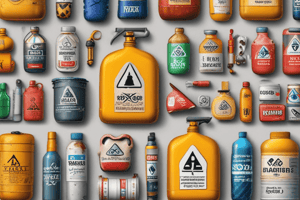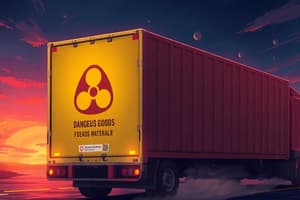Podcast
Questions and Answers
Which hazard class corresponds to explosives with a mass explosion hazard?
Which hazard class corresponds to explosives with a mass explosion hazard?
- 3
- 1.2
- 1.1 (correct)
- 2.1
What is the definition of 2.1 hazard class?
What is the definition of 2.1 hazard class?
Flammable gas
Match the following hazard classes with their definitions:
Match the following hazard classes with their definitions:
1.4 = Explosive with no significant blast hazard 3 = Flammable and combustible liquid 6.1 = Poisonous materials 7 = Radioactive material
Which hazard class is classified as corrosive?
Which hazard class is classified as corrosive?
Hazard class 4.2 refers to flammable solids.
Hazard class 4.2 refers to flammable solids.
Hazard class 2.2 refers to _____ compressed gas.
Hazard class 2.2 refers to _____ compressed gas.
Define the primary hazard.
Define the primary hazard.
Which hazard class/division is referred to as poisonous gas?
Which hazard class/division is referred to as poisonous gas?
What is the definition of infectious substance under hazard class 6.2?
What is the definition of infectious substance under hazard class 6.2?
What is a characteristic of organic peroxides in hazard class 5.2?
What is a characteristic of organic peroxides in hazard class 5.2?
Flashcards
Explosive Class 1
Explosive Class 1
Materials that readily detonate or explode, with varying degrees of sensitivity.
Flammable Gas (Class 2.1)
Flammable Gas (Class 2.1)
Gases that ignite in air mixtures within a specific range.
Non-flammable Compressed Gas (Class 2.2)
Non-flammable Compressed Gas (Class 2.2)
Compressed gases that do not ignite and may be asphyxiants or oxidizers.
Poisonous Gas (Class 2.3)
Poisonous Gas (Class 2.3)
Signup and view all the flashcards
Flammable Liquid (Class 3)
Flammable Liquid (Class 3)
Signup and view all the flashcards
Flammable Solid (Class 4.1)
Flammable Solid (Class 4.1)
Signup and view all the flashcards
Spontaneously Combustible (Class 4.2)
Spontaneously Combustible (Class 4.2)
Signup and view all the flashcards
Dangerous When Wet (Class 4.3)
Dangerous When Wet (Class 4.3)
Signup and view all the flashcards
Oxidizer (Class 5.1)
Oxidizer (Class 5.1)
Signup and view all the flashcards
Organic Peroxide (Class 5.2)
Organic Peroxide (Class 5.2)
Signup and view all the flashcards
Poisonous Material (Class 6.1)
Poisonous Material (Class 6.1)
Signup and view all the flashcards
Infectious Substance (Class 6.2)
Infectious Substance (Class 6.2)
Signup and view all the flashcards
Radioactive Material (Class 7)
Radioactive Material (Class 7)
Signup and view all the flashcards
Corrosive Substance (Class 8)
Corrosive Substance (Class 8)
Signup and view all the flashcards
Miscellaneous Hazardous Material (Class 9)
Miscellaneous Hazardous Material (Class 9)
Signup and view all the flashcards
Forbidden Materials
Forbidden Materials
Signup and view all the flashcards
Primary vs. Subsidiary Hazards
Primary vs. Subsidiary Hazards
Signup and view all the flashcards
49 CFR vs. IMDG
49 CFR vs. IMDG
Signup and view all the flashcards
Study Notes
Hazard Classes and Divisions
- Explosives (Class 1): Classifications vary from mass explosion hazards (1.1) like TNT to extremely insensitive detonating substances (1.6) with negligible initiation risks.
- Flammable Gases (Class 2.1): Ignite in air mixtures of 13% or less and examples include propane and LPG.
- Non-flammable Compressed Gases (Class 2.2): Asphyxiants or oxidizers, examples are nitrogen and helium.
- Poisonous Gases (Class 2.3): Highly toxic to humans, with examples like chlorine and hydrogen cyanide.
- Flammable Liquids (Class 3): Liquids with flash points below 150°F, such as gasoline and diesel fuels.
Solid Hazard Classes
- Flammable Solids (Class 4.1): Readily combustible materials including safety matches and firelighters.
- Spontaneously Combustible Materials (Class 4.2): Substances that heat up and can catch fire easily, like white phosphorus.
- Dangerous When Wet Materials (Class 4.3): Emit flammable gases when wet, examples include lithium and sodium.
Oxidizers and Peroxides
- Oxidizers (Class 5.1): Materials that enhance combustion and may form flammable gases upon contact with water.
- Organic Peroxides (Class 5.2): Thermally unstable substances with properties including rapid burning and explosive decomposition.
Toxic and Infectious Materials
- Poisonous Materials (Class 6.1): Cause serious health risks upon exposure, with examples such as lead oxide and cyanides.
- Infectious Substances (Class 6.2): Contain pathogens, including anthrax spores and HIV.
Radioactive and Corrosive Materials
- Radioactive Materials (Class 7): Emit unsafe energy types that can pose health hazards.
- Corrosive Substances (Class 8): Cause severe damage upon contact with living tissue or other materials, examples include car batteries and Draino®.
Miscellaneous Hazardous Materials (Class 9)
- Miscellaneous Hazardous Materials: Include substances like dry ice that present transport dangers not classified elsewhere.
Classification and Regulations
- Forbidden Materials: Certain explosives and electrical devices are restricted (e.g., lithium batteries with spark risks).
- Primary vs. Subsidiary Hazards: The primary hazard is the main risk, while subsidiary hazards refer to additional risks associated with the material.
- Regulatory Differences (49 CFR vs. IMDG): IMDG identifies dangerous goods, while CFR defines hazardous materials. ORM-D classifications are not recognized by IMDG.
Studying That Suits You
Use AI to generate personalized quizzes and flashcards to suit your learning preferences.




